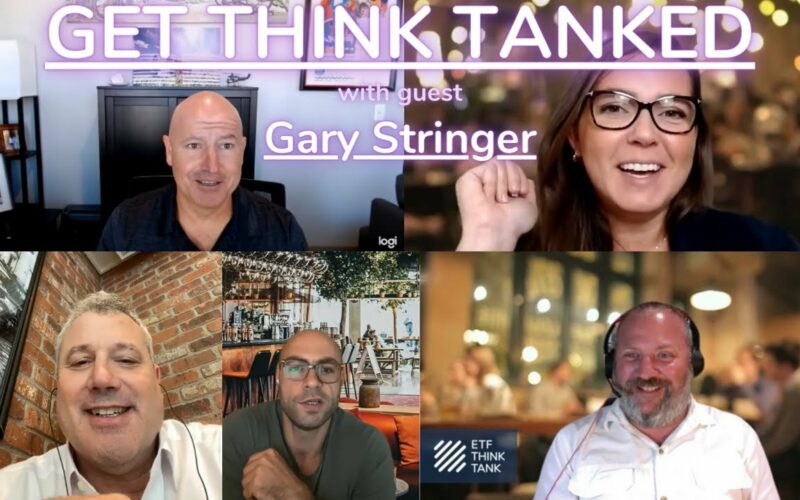After another wild week, which featured another hot inflation read and more instability in the bond market, it is helpful to reset where we are in the markets and where we might go from here. To do that, we brought Gary Stringer, the Chief Investment Officer at Stringer Asset Management, into the ETF Think Tank to offer up his thoughts on the state of the financial markets.
The discussion starts with Thursday’s market action, which saw a sharp decline in stocks followed up by an even sharper rebound. What exactly happened? Stringer says his firm tends not to pay a lot of attention to short-term moves because they are mostly noise. In this case, he feels like maybe the market was due for a bit of a rebound with sentiment looking quite bearish at the moment. Perhaps there was a feeling of “it can’t get much worse”, but it is difficult to ascribe one specific reason.
Stringer wasn’t entirely surprised by the September inflation reading, but he does see it continuing and those views remain intact. He does note, however, that several inflationary factors, such as money growth and commodities prices, are already starting to roll over. The core inflation rate is a bit of a laggard, but he expects the headline rate to start declining soon, maybe even quickly.
One thing in which Stringer’s view has changed a bit is that he views a recession next year as a probability, not just a possibility. We’re in a technical GDP recession right now, but he is waiting for earnings to be the next big shoe to drop. His company is looking for the point where job creation begins declining, the unemployment rate begins ticking up, consumption decreasing, and retail sales falling. Stringer believes these things will begin appearing next year, which will drag down earnings expectations. A lot of this, he believes, is already priced in, but we could remain in a trading range until some of this is resolved.
One of the big advantages this time around, compared to the financial crisis, is that the big banks are in much better shape. Jerome Powell and the Fed have clearly telegraphed their intentions and that’s given the financial institutions plenty of time to prepare. Unfortunately, the Fed was so far behind in responding to changes in conditions that the stock prices of these companies are likely to struggle. Overall, the banks are in good shape to be able to ride out this storm.
When it comes to the bond market, Stringer is cautious, yet opportunistic. Earlier in the year, he was heavier in floating rate notes and focused on low-rate sensitivity fixed income. Now, he’s eliminated corporate bonds, but has been adding intermediate-term Treasuries and munis. He feels like he is buying high quality fixed income and getting paid for it for the first time in years. His research has noted that when the yield curve inverts, the 10-year Treasury yield traditionally keeps moving lower, so he feels there is some opportunity there. Stringer thinks that 10-year yields are too high right now and Treasuries could be interesting for a while.
Other key takeaways:
- Stringer liked TIPS last year, but feels the upside is now gone and there is a lot more risk involved.
- He’s also avoiding bank loans at the moment. His company had them early on when it was more constructive on the economic environment, but there’s a fair amount of credit and liquidity risk there. If everybody decides to head for the exits, it really adds to risk.
- Fat tail events are always a risk, but with balance sheet health the way it is, it’s probably not as likely today. Stringer uses ETFs with a built-in options hedge as part of his defensive strategy.
- Stringer overlays everything the company does with his “cash indicator”, which is designed to alert him to when things are turning very adverse. It helps delineate between “normal, but scary” and “things are really falling apart”.
- Stringer thinks that the dollar will remain strong for some period of time citing the BoE’s actions with regard to pension plans and the BoJ’s on yield curve control. That means the Fed likely won’t have to do as much easing comparatively speaking.
- Multiple contraction has been severe, but that’s part of the reason he’s still holding onto big tech. If rates come back down, that could unlock a lot of value.
You can watch a replay of this virtual happy hour on our YouTube channel here. While there, subscribe to our channel to stay up to date on our latest content.
Disclosure
All investments involve risk, including possible loss of principal.
The material provided here is for informational purposes only and should not be considered an individualized recommendation or personalized investment advice. The investment strategies mentioned here may not be suitable for everyone. Each investor needs to review an investment strategy for his or her own particular situation before making any investment decision.
All expressions of opinion are subject to change without notice in reaction to shifting market conditions. Data contained herein from third party providers is obtained from what are considered reliable sources. However, its accuracy, completeness or reliability cannot be guaranteed.
Examples provided are for illustrative purposes only and not intended to be reflective of results you can expect to achieve.
The value of investments and the income from them can go down as well as up and investors may not get back the amounts originally invested, and can be affected by changes in interest rates, in exchange rates, general market conditions, political, social and economic developments and other variable factors. Investment involves risks including but not limited to, possible delays in payments and loss of income or capital. Neither Toroso nor any of its affiliates guarantees any rate of return or the return of capital invested. This commentary material is available for informational purposes only and nothing herein constitutes an offer to sell or a solicitation of an offer to buy any security and nothing herein should be construed as such. All investment strategies and investments involve risk of loss, including the possible loss of all amounts invested, and nothing herein should be construed as a guarantee of any specific outcome or profit. While we have gathered the information presented herein from sources that we believe to be reliable, we cannot guarantee the accuracy or completeness of the information presented and the information presented should not be relied upon as such. Any opinions expressed herein are our opinions and are current only as of the date of distribution, and are subject to change without notice. We disclaim any obligation to provide revised opinions in the event of changed circumstances.
The information in this material is confidential and proprietary and may not be used other than by the intended user. Neither Toroso or its affiliates or any of their officers or employees of Toroso accepts any liability whatsoever for any loss arising from any use of this material or its contents. This material may not be reproduced, distributed or published without prior written permission from Toroso. Distribution of this material may be restricted in certain jurisdictions. Any persons coming into possession of this material should seek advice for details of and observe such restrictions (if any).












